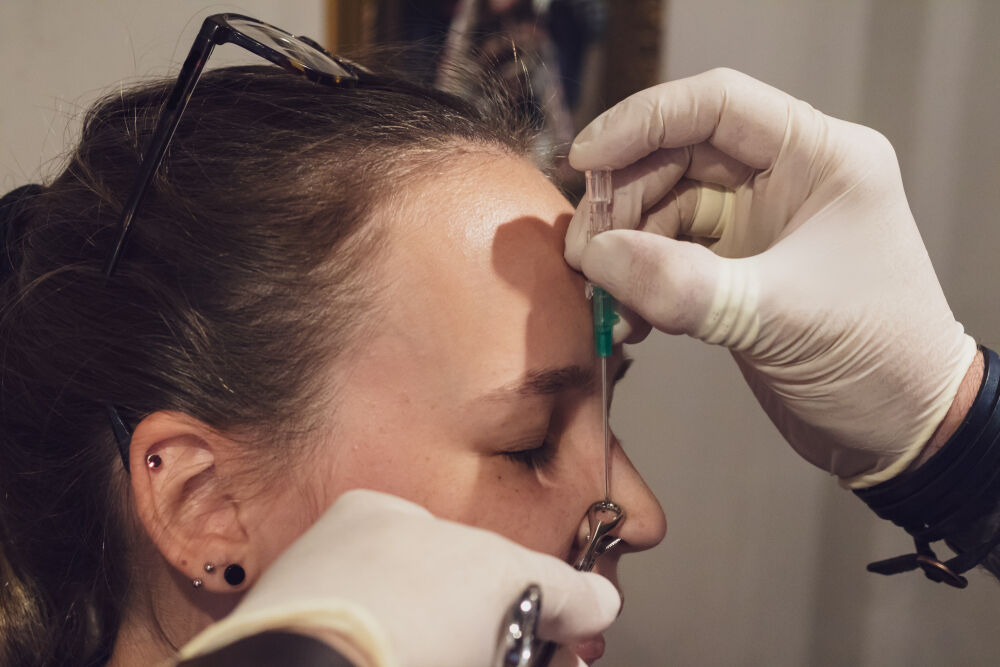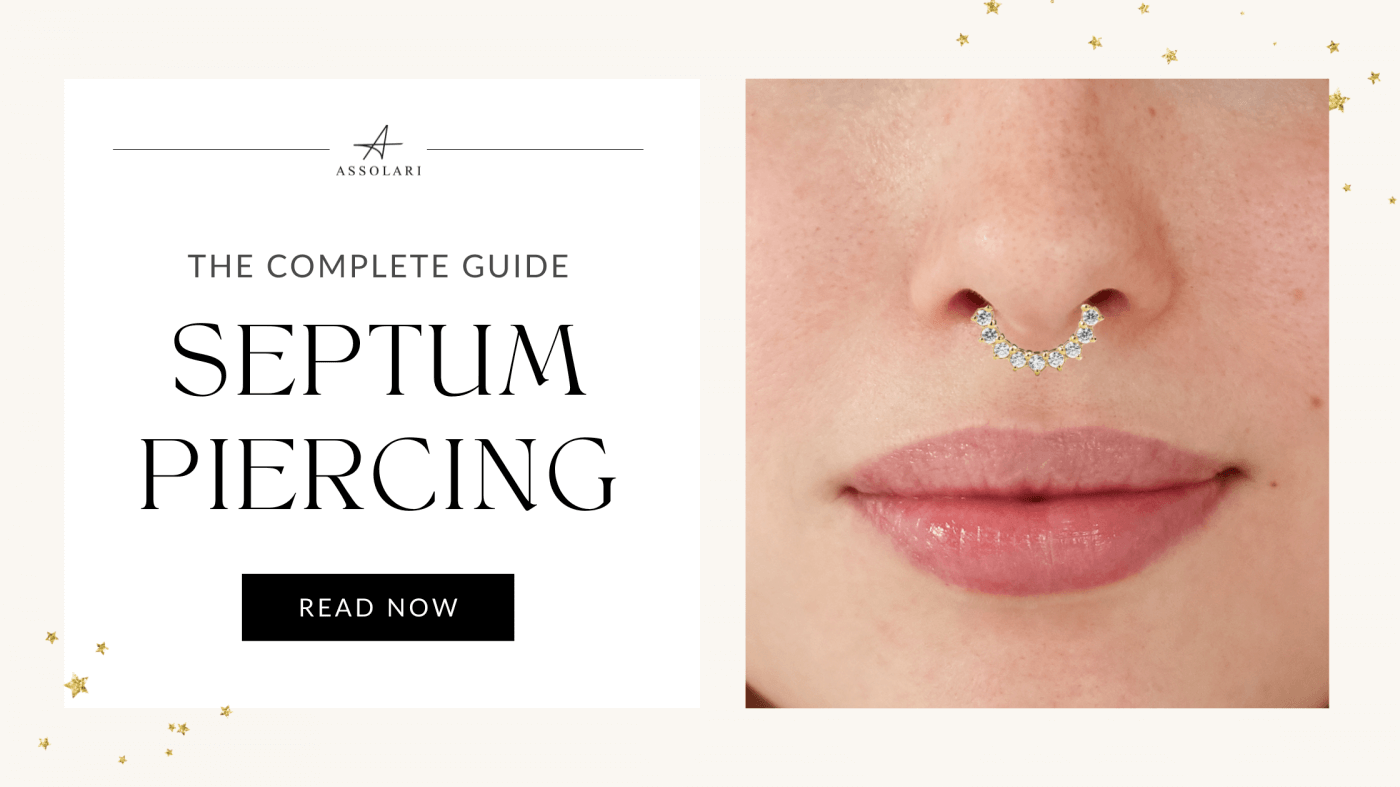Septum piercing is a straightforward procedure that involves passing a hollow needle through the septum tissue, the cartilage between the nostrils, and inserting jewelry. To prepare for septum piercing, it is essential to avoid getting the piercing during allergy seasons if you have hay fever.
Keeping your nose clean during healing is crucial to preventing infection, so waiting until your seasonal allergies have passed is best. Additionally, make sure to eat a meal or have a snack a few hours before the piercing and stay hydrated.
What Is A Septum Piercing?
A septum piercing refers to the piercing of the cartilage between the nostrils. Before getting this type of piercing, it’s essential to prepare by avoiding piercing during allergy seasons and keeping the nose clean to prevent infection.
Introduction To Septum Piercing
Septum piercing is a unique form of body modification that has recently gained popularity. It involves hitting the thin strip of skin, known as the septum, that separates the nostrils. Unlike nostril piercings, which are more commonly seen, septum piercings require careful consideration and preparation.
Understanding The Piercing Process
Getting a septum piercing is straightforward, but a professional piercer should always do it. The piercer will start by cleaning the area with an antiseptic solution to ensure a sterile environment. Then, they will mark the spot where the piercing will be done, considering the desired placement and jewelry size. Once the marking is complete, a hollow needle will be passed through the septum, creating a small hole. Finally, the piercer will insert the jewelry into the newly created opening, usually a circular barbell or a captive bead ring.
Pain, Aftercare, And Healing Process
It’s important to note that the pain associated with septum piercing varies from person to person. Some individuals describe it as a sharp pinch, while others report minimal discomfort. After the piercing is done, the healing process begins. It typically takes 6 to 8 weeks for the initial healing, during which time it’s crucial to follow proper aftercare practices.
During the healing process:
- Clean the piercing twice daily with a saline solution or a saltwater soak.
- Avoid touching the jewelry or rotating it excessively.
- Avoid submerging the piercing in bodies of water, such as swimming pools or hot tubs.
- Avoid applying makeup, lotions, or creams to the area.
If you experience any pain, swelling, redness, or discharge, it’s essential to consult with your piercer or a healthcare professional. Additionally, it’s necessary to be mindful of the jewelry material, as some individuals may have allergies or sensitivities to certain metals, especially nickel. Opting for high-quality materials like surgical stainless steel or titanium can help minimize the risk of allergic reactions.
Following proper aftercare and staying patient during healing can ensure a healthy and prosperous septum piercing. Everyone’s body is different, so the healing time may vary. Consult with your piercer for any concerns or questions throughout the process.

Preparing For A Septum Piercing
Getting a septum piercing is an exciting and personal decision. However, it’s essential to consider specific considerations and prepare yourself properly for the procedure. Understanding the potential risks and caring for your new piercing properly can ensure a smooth healing process. Here are some essential things to keep in mind:
Considerations And Potential Risks
Before getting a septum piercing, knowing the potential risks is crucial. While it is generally a safe procedure, understanding these risks can help you make an informed decision.
- Allergic Reactions: Some piercing jewelry, especially those containing nickel, can cause allergic reactions in specific individuals. It’s important to choose hypoallergenic materials to minimize the risk.
- Infections: Openings in the skin during healing can make your body susceptible to bacterial infections. Proper aftercare and hygiene practices are essential to preventing infections.
- Septal Hematoma: This is a rare but possible complication involving blood collection between the cartilage layers in your septum. Seek medical attention if you experience severe pain, swelling, or a lump.
- Bloodborne Diseases: Although the risk is low, ensuring that the piercing studio follows strict sterilization procedures is essential to minimizing the risk of bloodborne diseases.
- Scarring and Tearing: Improper aftercare and handling of the piercing can lead to scarring or tearing of the tissue. Avoid any activities or behaviors that may put a strain on the piercing.
Dos And Don’ts For Aftercare
Proper aftercare plays a crucial role in the healing process of your septum piercing. Following these dos and don’ts will help ensure a healthy and hassle-free healing process:
- Wash your hands thoroughly before touching your nose or the piercing area to prevent the transfer of bacteria.
- Don’t twist or flip the jewelry unnecessarily. If you need to adjust it, use warm water to gently loosen any crust before moving it.
- Clean the piercing twice daily using a saline solution or a mild, fragrance-free soap recommended by your piercer.
- Don’t use harsh soaps, alcohol, hydrogen peroxide, or iodine on the piercing, as these can irritate the skin and delay healing.
- Be mindful when changing clothes or putting on scarves to prevent snagging the jewelry and causing discomfort.
The Process Of Getting A Septum Piercing
The process of getting a septum pierced involves a few simple steps performed by a professional piercer:
- The piercer will clean the area with an antiseptic solution to ensure proper hygiene.
- The spot where the piercing will be done is marked to ensure accurate placement.
- A hollow needle is then passed through the tissue, creating the opening for the jewelry.
- Finally, the chosen jewelry is inserted into the newly pierced septum.
Remember, the procedure should always be carried out by an experienced piercer who follows strict sterilization protocols to ensure your safety and minimize the risk of complications. Following the aftercare instructions provided by your piercer will help ensure a smooth healing process and allow you to enjoy your new septum piercing to the fullest.
Tips And Advice For Getting A Septum Piercing
Thinking of getting a septum piercing? Preparing yourself physically and mentally ensures a smooth and successful piercing experience. Here are some tips and advice to help you get ready:
Preparing Yourself Physically And Mentally
Before you go ahead and get your septum pierced, it’s essential to be in the best physical and mental state possible. Here’s what you need to do:
- Choose the right time: Avoid getting your septum pierced during allergy seasons if you’re prone to hay fever. Wait until your seasonal allergies have passed to prevent complications during the healing process.
- Keep your nose clean. Cleanliness is crucial to preventing infection. Keep your nose clean before the piercing by practicing good hygiene habits.
- Research reputable piercers. Take the time to find a professional piercer with experience and a clean working environment. Read reviews and ask for recommendations to ensure you’re in safe hands.
- Prepare mentally: Understand that getting a septum piercing may cause discomfort or pain. Prepare yourself mentally by embracing the process and knowing that it’ll be worth it in the end.
What To Expect During And After The Piercing
Knowing what to expect during and after the piercing can help ease any concerns or anxiety. Here’s an overview:
- Piercing process: The piercer will clean the area with an antiseptic solution and mark the spot where the piercing will be done. A hollow needle will then be passed through the tissue, and the jewelry will be inserted.
- Pain level: Pain levels can vary from person to person, but most individuals describe the pain as a quick pinch or pressure sensation. The entire process is relatively short.
- Healing process: The healing process typically takes around 6–8 weeks. During this time, it’s essential to take proper care of your piercing by following aftercare instructions provided by your piercer.
Helpful Tips For A Successful Healing Process
Ensuring a successful healing process is essential for your septum piercing. Here are some helpful tips to follow:
- Please keep it clean. Clean your piercing daily with a saline solution or a gentle, fragrance-free soap. Avoid using harsh soaps, alcohol, hydrogen peroxide, or iodine on the septum, as they can irritate the piercing.
- Avoid touching it. Please resist the temptation to touch or play with your new piercing, as it can introduce bacteria and slow healing. Only handle it when necessary, such as during cleaning.
- Avoid twisting or flipping the jewelry. Unless instructed by your piercer, avoid unnecessarily turning or flipping the jewelry unnecessarily. If you must adjust it, use warm water to loosen any crust buildup first.
- Watch out for signs of infection: Keep an eye out for symptoms of infection, such as excessive swelling, redness, persistent pain, or discharge. If you notice anything concerning, seek professional medical help.
Following these tips and advice will prepare you for your septum-piercing journey. Consult a professional piercer for personalized guidance and instructions to ensure a safe and successful experience.


Frequently Asked Questions For Septum Piercing: What Is It And How Do You Prepare For It?
How Do I Prepare Myself For A Septum Piercing?
To prepare for a septum piercing, avoid getting it during allergy seasons if you have hay fever. Keep your nose clean during the healing process to prevent infections. Before touching your nose, wash your hands, and avoid twisting or flipping the jewelry.
Do not use harsh soaps or alcohol on the piercing. The process involves cleaning the area, marking the spot, passing a needle through the tissue, and inserting the jewelry.
What to Consider Before Getting Septum Piercing?
Before getting a septum piercing, consider the following: – Wait until allergy seasons have passed if you are prone to hay fever. – Keep your nose clean during the healing process to prevent infection. – Be aware of potential risks such as allergic reactions, infections, septal hematoma, bloodborne diseases, scarring, and tearing.
– Avoid twisting or flipping the jewelry and use warm water to loosen any crust if necessary. – Follow a proper process with a professional piercer, including cleaning the area, marking the spot, and inserting the jewelry.
What to Avoid When Getting Septum Piercing?
To avoid complications when getting a septum pierced, follow these guidelines: do not pierce your septum during allergy seasons, as runny noses make piercing care difficult. Always wash your hands before touching your nose. Avoid twisting or flipping the jewelry; if necessary, use warm water to loosen any crust first.
– Do not use harsh soaps, alcohol, hydrogen peroxide, or iodine on the septum.
What Is The Process Of Getting A Septum Piercing?
Getting a septum pierced involves cleaning the area, marking the spot, using a hollow needle to penetrate the tissue, and inserting the jewelry. It is important to avoid twisting or flipping the jewelry and to keep the nose clean during the healing process to prevent infection.
Conclusion
To prepare for a septum piercing, keeping a few things in mind is crucial. Avoid getting the piercing during allergy seasons to prevent complications. Keep your nose clean during the healing process to minimize the risk of infection. Additionally, be mindful of potential risks such as allergic reactions, infections, and scarring.
Following these guidelines and practicing proper aftercare will ensure a smooth healing process for your septum piercing.
DIY hair oils are some of the most important ingredients to have in your beauty arsenal. They add shine, manage frizzy hair, and help improve your hair health.